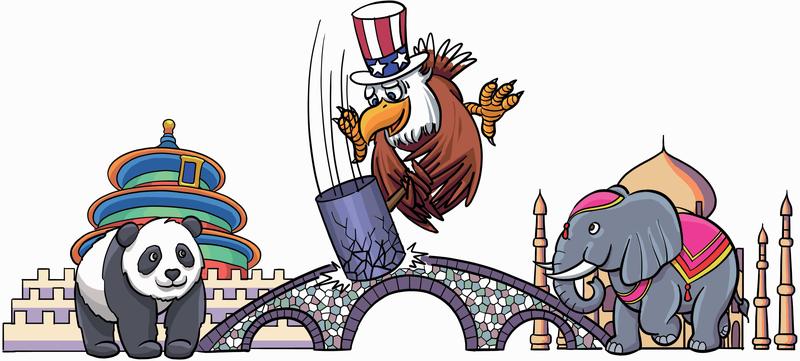 (JIN DING / CHINA DAILY)
(JIN DING / CHINA DAILY)
The United States has been trying to coerce India into joining its anti-China front, and as part of its efforts, US troops even held a joint military drill with the Indian armed forces near the China-India border. But since India has its own interests to safeguard, it will not be easily manipulated by the US-and that's a key reason why it walked out of the talks on the trade pillars of the "Indo-Pacific Economic Framework for Prosperity" last week.
On the other hand, tensions on the China-India border have eased and political ties are returning to normal thanks to the joint efforts of the two countries' leaders and their foreign ministries and military departments. Chinese State Councilor and Foreign Minister Wang Yi has met with Indian External Affairs Minister Subrahmanyam Jaishankar twice, reaffirming the consensus reached by the two heads of state that the two countries, instead of posing a threat to each other, offer mutual development opportunities.
And India, for its own and common benefit, should foster China-India ties with more care, and prevent becoming a pawn in Washington’s strategic and geopolitical games
Also, Sino-Indian trade continues to grow despite the global economic downturn. Bilateral trade, which grew 16 percent year-on-year from January to August, is set to reach $100 billion in 2022.
People-to-people and cultural exchanges, too, have resumed due to the dynamic adjustments in the two countries' anti-pandemic measures.
Apart from urging Russia and Ukraine to stop the conflict and settle their differences through peaceful means and opposing the US' sanctions against Russia and other countries on the pretext of trying to resolve issues, China and India are also striving to fulfill their common but differentiated responsibilities in the global fight against climate change as part of their international duties.
The two countries' moves and actions reflect the common interests of developing countries as well as their need for industrial upgrading and structural transformation of the energy sector to meet the Paris Agreement targets. The two sides have also adopted a similar stance on issues such as energy security, food security and global supply chain stability.
Since these facts are to Washington's disliking, US politicians have been desperately trying to poison Sino-Indian relations, in a bid to prompt New Delhi to jump on Washington's anti-China bandwagon. The US has also been trying to drive a wedge between India and Russia, so as to snatch a share of Russia's arms deals with India.
Back home, US House Speaker Nancy Pelosi's recent visit to Taiwan has further heightened tensions across the Taiwan Straits in particular, and the Asia-Pacific region in general. As for the US administration, it has been trying to hollow out the one-China principle, thus raising the risk of a military conflict. That Washington has triggered conflicts and geopolitical crises at both ends of Eurasia exposes its moral bankruptcy and inability to manage international relations.
Unfortunately, India has unwittingly become a pawn in the US' geopolitical game. Unable to resist Washington's diplomatic offensive over the past few years, India has signed a series of military and security agreements with the US, giving it a backdoor entry into India's weapons and military equipment sector. This has seriously eroded India's strategic autonomy.
Both China and India have long insisted that border disputes be resolved through bilateral negotiations, free of any third-party intervention. They have also achieved an orderly military "disengagement" in some border areas through diplomatic and military dialogues since the Galwan Valley clash in June 2020. And after holding three rounds of commander-level talks this year, the two sides have agreed to maintain military and diplomatic communication and settle the border issue through dialogue and consultation.
Both China and India know that it is not in the interest of either country for a third party to intervene in their territorial dispute. That's why when previous US president Donald Trump tweeted in May 2020 that he was ready to mediate the Sino-Indian border dispute, he was given a cold shoulder by India.
The Indian strategic circle is worried that once the Sino-Indian border dispute is "internationalized", the US may also intervene in its border disputes with Pakistan, and Nepal.
China-India relations, which have a long history, cannot be made a victim of the US' geopolitical games. Since the normalization of relations in 1988 after the 1962 Sino-Indian border conflict, Beijing and New Delhi have continued to expand and deepen their engagements.
And since both sides attach the greatest value to independence, which has become dearer in the current global environment, they should be strategically focused on longer-term prospects, work together to prevent the US from sparking a new Cold War, jointly maintain regional peace and stability, and promote development. And India, for its own and common benefit, should foster China-India ties with more care, and prevent becoming a pawn in Washington's strategic and geopolitical games.
The healthy development of Sino-Indian relations will not only help the two sides to achieve their respective goals of sustainable economic growth, improving people's livelihoods, and achieving national rejuvenation, but also inject positive energy into and stabilize the turbulent world.
Lan Jianxue is the director of the Department for Asia-Pacific Studies at the China Institute of International Studies; and Lin Duo is a scholar at the same department.
The views do not necessarily reflect those of China Daily.


